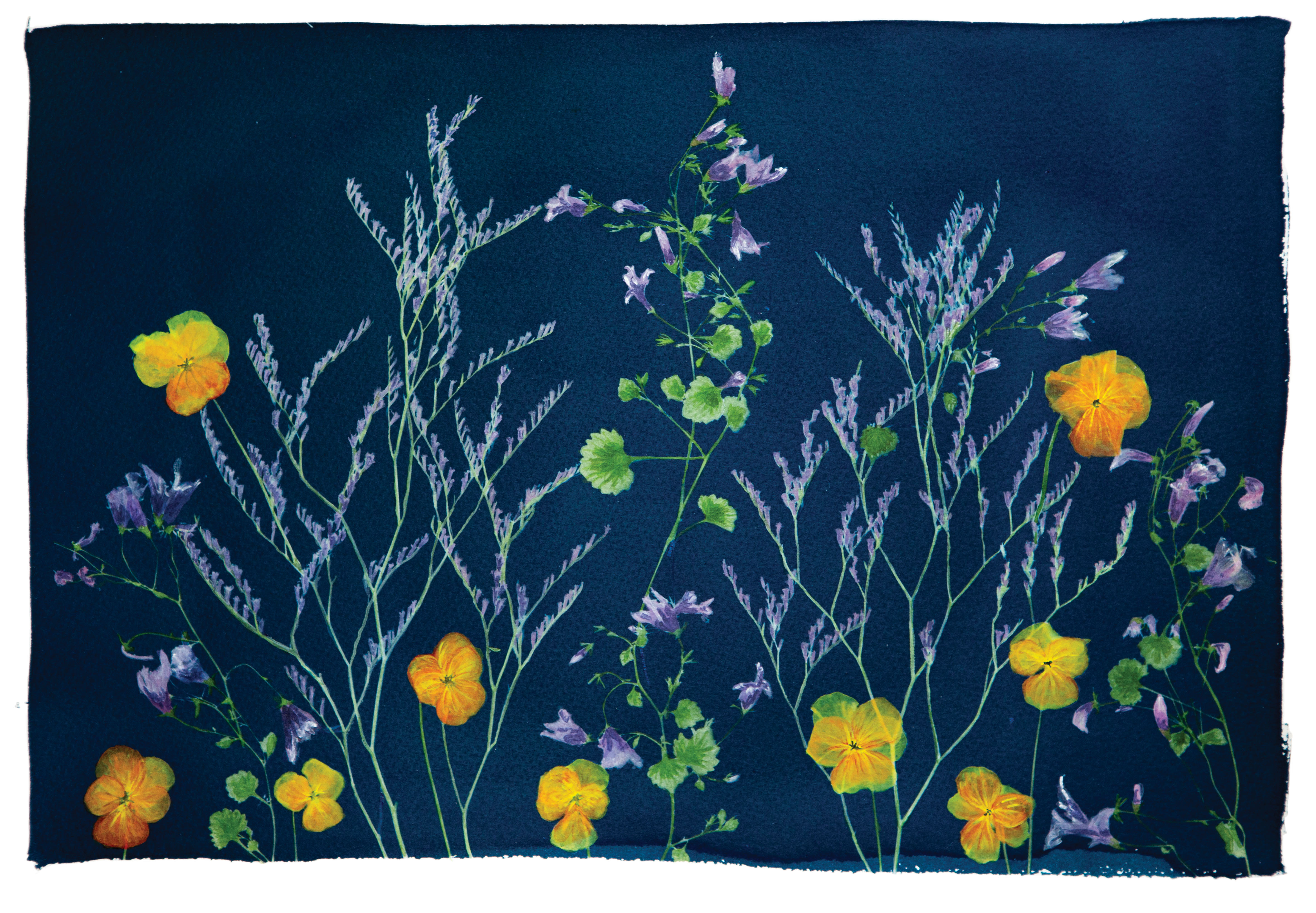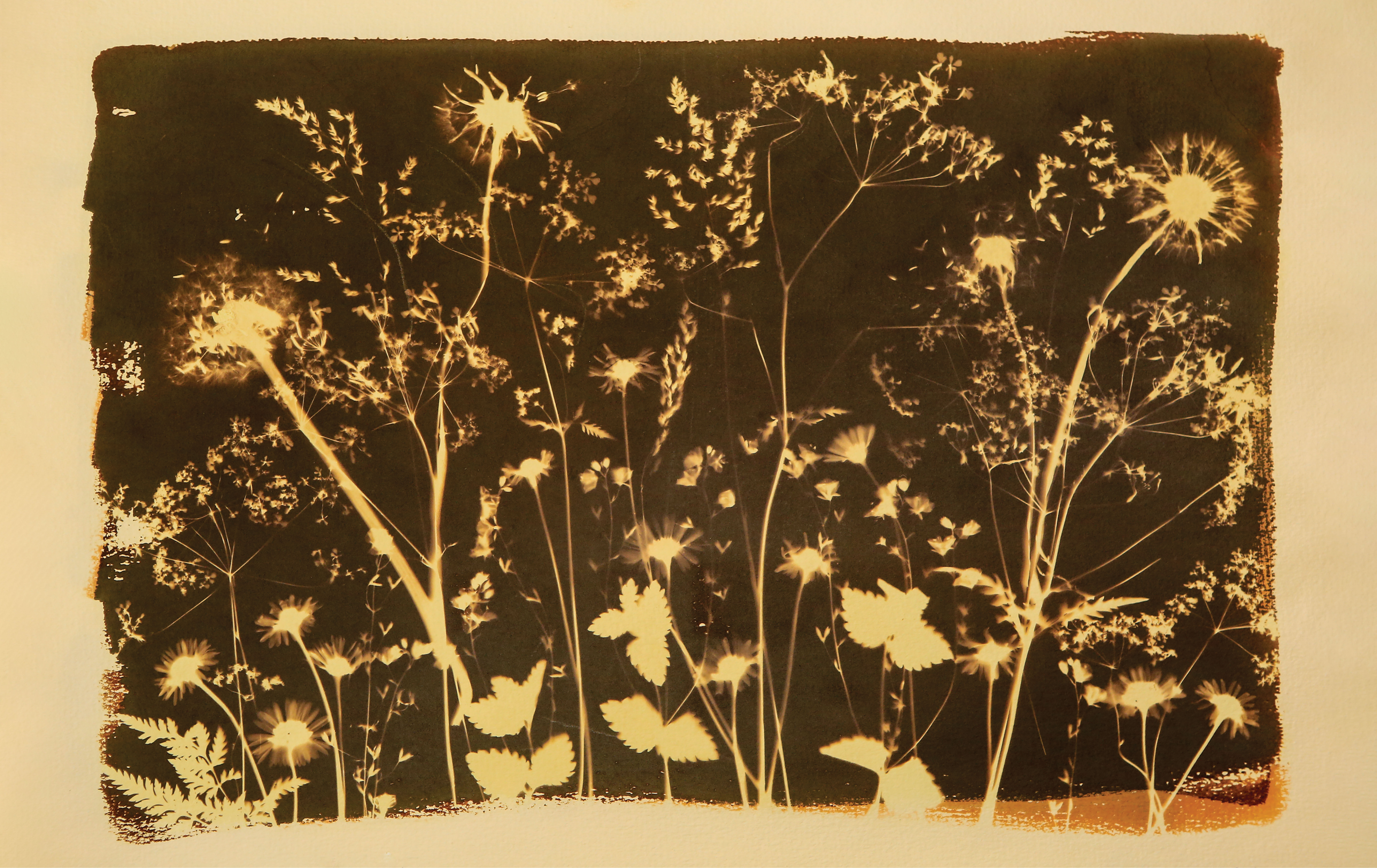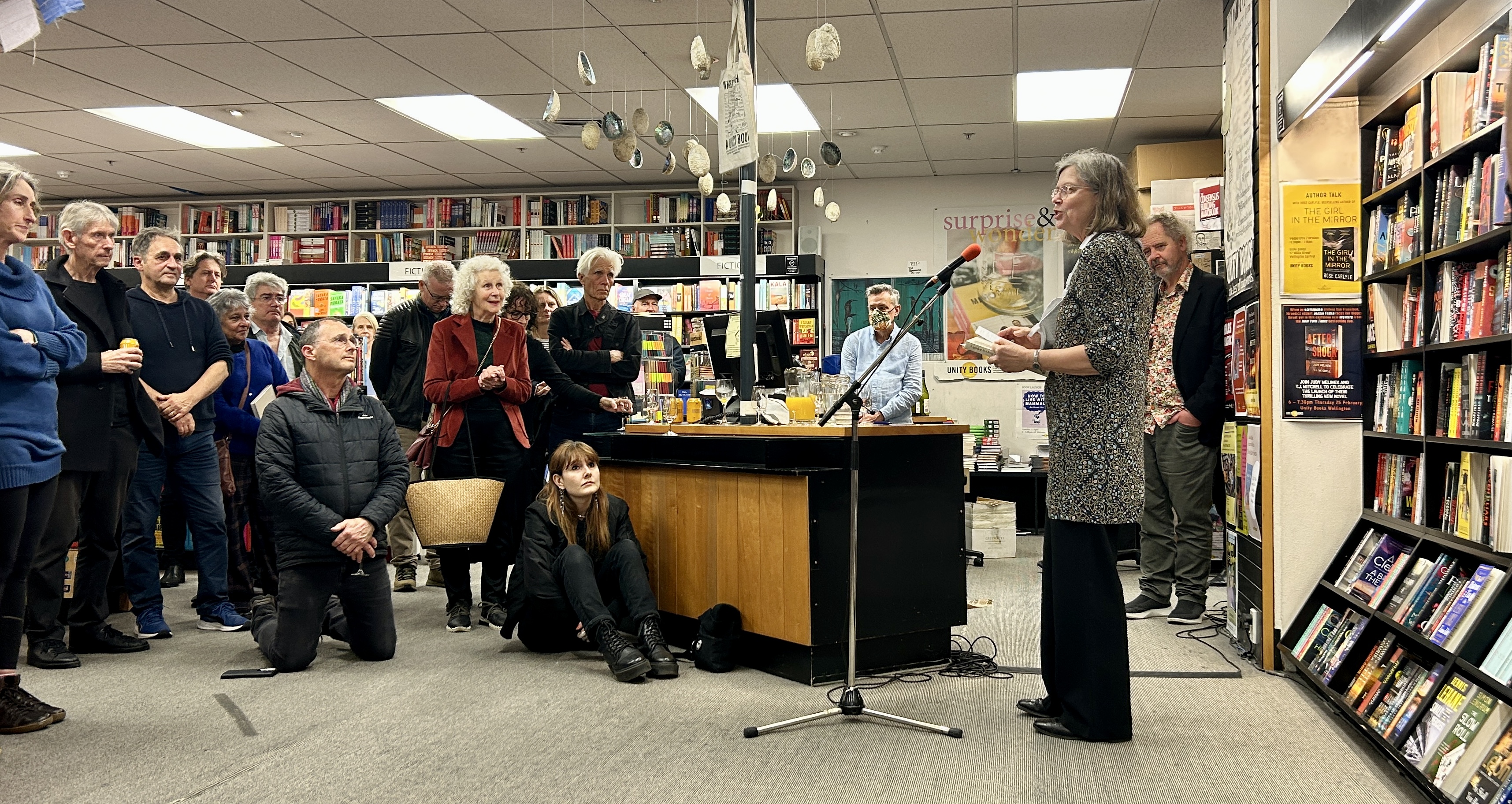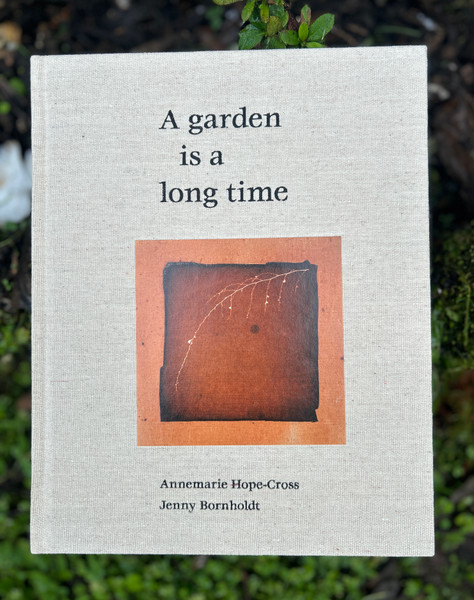'Time past, time slowed down, time taken and given': A Garden Is a Long Time launch
Posted by Ashleigh Young on 19th Jul 2023
On Tuesday 18 July we were thrilled to officially launch A garden is a long time, by Annemarie Hope-Cross and Jenny Bornholdt, at Unity Books Wellington. Lissa Mitchell, curator of historical photography at Te Papa and author of Through Shaded Glass: Women and Photography in Aotearoa 1860–1960 (Te Papa Press), talked to us about Annemarie and her work.

Annemarie Hope-Cross, Wildflower Meadow – Spring I, 2021, hand-coloured cyanotype
Annemarie Hope-Cross is part of an international movement in rediscovering and using historic analogue photographic processes to make contemporary photography. Throughout her career Annemarie used several processes developed in the 1830s and 1840s in England and Europe. Described in terms such as ‘developing out’, ‘printing out’, and ‘cameraless’ they include unique images in wet collodion on tin (known as tintypes) and on glass (known as ambrotypes), cyanotypes on glass and paper supports, delicate salted paper negatives (as for her Still series), anthotypes (using plant-based developers), and hand colouring.
Aotearoa New Zealand photographic history has very few photographs made with some of these earlier photographic processes, and I know of no historic examples made here. This is understandable, as they were mainly in use prior to, and the decade following, the signing of Te Tiriti o Waitangi. However, Hope-Cross’s work encodes this pre-commercialised era of the history of photography into Aotearoa, and she is an example of a maker developing her own response to the traditional history of photography as prescribed by Europe and the US.
I first met Annemarie at Photobook here in Wellington in 2019. I was researching and planning my recently published book – Through Shaded Glass – on the involvement of women in the history of photography in Aotearoa New Zealand up to 1960. There were many breakthroughs with the project in terms of confirming the identify of different people and finding examples of their work. One of the most cryptic involved the identity of Margaret Lea – the name of a photographic studio that operated in Auckland during the 1950s.
Anyway, not long after Photobook, Annemarie contacted me, as she – rightly – thought I would like to hear about Margaret McNulty, a photographer who grew up in Central Otago and started her photography career there during the 1930s before moving to Auckland. McNulty, born in 1906, was a woman photographer who had taken the reverse journey to Annemarie’s – moving from Cromwell to Auckland to further her photography. Annemarie had located and contacted the elderly niece of Margaret McNulty and a productive correspondence took place that resulted in the uncovering of the identity of Margaret Lea – not a real person but a name made up from the combination of the names of the two women business partners – in this case Margaret for Margaret McNulty and LEA – the initials of the other partner, Lesley Erne Adams.
I realised Annemarie and I got each other when I mentioned how I was trying to focus more on studying the ‘making’ of photographic images, not just the ‘taking’ of them. For Annemarie, photography was all about the ‘making’ of images – she would assemble scenes which took time to expose, often up to 8 hours, thwarting any notions of a decisive moment. At this time Annemarie was working on her Still series, by making her own salted paper negatives and exposing them in her mousetrap camera. These were then finished as archival pigment prints.
Annemarie also made cameraless prints using
the cyanotype and anthotype processes. These works, usually featuring botanical
specimens, also tap into a long and rich history of photographic processes and
their relationship to elements from nature, and personalities too vast to go
into here. But Annemarie’s photograms of seaweeds – in wet collodion (not
cyanotype) – are for me a nod to Anna Atkins who published the first known
photobook (cyanotypes of specimens of British algae) in 1843. While Annemarie’s
collection of plant specimens from her garden and, presumably, in exchange with
others (‘Roses from the south’; seaweed in land locked Central Otago?) or,
perhaps, collected on her travels are recorded in cameraless prints that are
part of a history of local photographers - such as Mary and Herbert Dobbie who
produced the New Zealand Ferns – an edition of unique books made
entirely from bound cyanotype prints, which were published in 1880; and Anna
Elizabeth Jerome Spencer who worked in partnership with Herbert Guthrie-Smith
to produce photographs from the 1890s of Guthrie-Smith’s botanical collections
and birding expeditions.

Annemarie Hope-Cross, Wildflower Meadows, Abbey Entrance, 2013, photogenic drawing (made at Lacock, Wiltshire)
I have been reflecting since my book was published about how in researching so firmly in the past that in the process I met and got to know so many contemporary photographers. My field is usually a lonely one especially in New Zealand, but ironically in this case the past has brought me into a very present and engaged community of makers. Annemarie was, and her work will continue to be, part of this strong and vibrant community of artist photographers who are working with analogue processes and developing relationships between this place and the history of photography, and it is so exciting to be watching them do it.
But back to Annemarie’s work. A sense of intensity comes through when I view the Still series. Annemarie’s scenes – fragments of captured moments in time embody the process of their production – they are proof of presence more so than appearance. They are not about being modern or capturing the fleeting and fast moving or recording scientific information – traits so readily appended to the notion of photographic progress. But rather slowness, rest, and the needs of the body as part of the creative process and sometimes that process is full of – as Jenny Bornholdt put it on Kim Hill on Saturday – ‘heavy heartedness’. But slowing down wasn’t new – it was already part of Annemarie’s life and practise – illness just meant going even slower.
But just working in a historical process doesn’t make photographs into works of art. It’s hard to pin down how I feel about the Still series. It tugs at a lot of my own memories and knowledge of the place, but it also pulls me back to the bigger context. I am struck by how they draw me into my own specific connections but don’t leave me dwelling in nostalgia. But, rather, thinking about the minerals in the water and the land – namely those used in photography - salt, gold, and silver – and their relationship to photography especially its origins in England and Europe and those places connections to colonialisation. Contemporary analogue photography shouldn’t just leave us reflecting on a notion of the past with a nostalgic lens but have us investigating and appreciating the complexity of the labour and resources that make photography possible and show a continuity between photography’s past and present.
I was pleased to be able to include Annemarie’s Heidelberg Apotheke, an image from the Still series in the epilogue of my book. It features two glass bottles (posed together like bride and groom), and shrouded in a veil like mist the nature of which I can only speculate – is it steam, smoke, or chemically derived? And what about the magic to create this image – how did she get this delicate, wafting substance to linger for eight hours? Or is it a trick involving the manipulation of the negative? I don’t want to know – I want to keep the magic alive.
Time is encoded in my response to seeing the Still series – time past, time slowed down, time taken and given, time as a fragment of a past that is continuing into the present and resonates with the environment and our impact on it. Someone poured from this bottle and sipped from this cup and handed them on. We live within time with these objects. We make images and images make us.
Annemarie – I am so sorry you are not
here to enjoy your beautiful book and share in this much deserved celebration
tonight but – thank you for your work and this gift you have given us.
—Lissa Mitchell

Publisher Fergus Barrowman (talking about the importance of paper)

Poet Jenny Bornholdt
A garden is a long time (NZ$50, hardback) is out now and is available from Unity Books, all other good bookstores, and our website.

